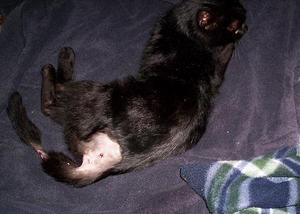Feline abscesses can be more serious than you might think. Infection can spread, causing severe pain, lameness, and– if the abscess is left untreated– even death. Every cat owner should be aware of the causes and symptoms of feline abscesses.
The common causes of abscesses in cats:
Bite wounds are the most common cause of feline abscesses; therefore, outdoor cats are most likely to develop an abscess, though an abscess can develop in any cat with a puncture wound. Fights can lead to terrible bites that leave deep bacteria-filled punctures. Skin quickly surrounds these wounds and traps the infection inside, where bacteria multiply rapidly in the warm, moist environment.
The symptoms of abscesses in cats:
Unfortunately, the wound often goes unnoticed by the pet owner until it begins causing serious problems for the cat and/or has grown large with pus.
A cat with an abscess should be taken to a veterinarian as soon as possible. Antibiotics are usually prescribed to combat the infection and sometimes the abscess must be surgically drained. Recovery depends on the severity of the wound, the general health of the cat, and promptness of wound treatment.
Detecting abscesses in cats:
Any bump or lump on your cat should be investigated. Frequently, cats with an abscess will show few or no symptoms. Sometimes the cat will have a fever and the area of the wound will be warm to the touch and/or may be foul smelling and weepy. Puncture wounds are usually small and difficult to detect
Case study:
In early spring of 2007, I noticed a black stray cat limping through my backyard. I went out to investigate. She let me draw near but would not let me touch her. I could not see any external injuries and had no idea what could be wrong with her. I feared a car had hit her.
The first day I was unable to catch her. It was not until several days later that I was able to get close again and was able to bring her inside. She was very weak and clearly in pain but she allowed me to examine her more closely.
I noticed fur missing from two areas on her hindquarters; one bald area was near her tail. I could see very small wounds that were seeping a clear, foul-smelling, fluid. To my untrained eye, the wounds did not appear to be bite wounds. The emergency veterinarian would later tell me they were, nevertheless, bite wounds.
The cat was barely able to walk and I feared she had a fracture in her tail–a potentially fatal injury in cats. She rested quietly on a blanket in the middle of the floor while I called an emergency animal hospital to let them know I was about to bring in an injured cat.
I named her Athena and got her checked out quickly. The vet knew what the wounds were immediately. I was surprised that they were abscessed wounds and that she did not have a fracture; I had no idea that an abscess could cause the severity of symptoms she was experiencing–especially the acute lameness in her hindquarters.
The emergency vets surgically drained one of the abscesses and removed necrotic tissue from the other. She was given antibiotic injections and was put on oral antibiotics as well. I was instructed to take her to a vet again within no more than three days to make sure she was healing properly.
Athena did not tolerate the liquid antibiotics well and had to be placed on antibiotic pills instead. However, in just a few days, she was feeling much better and the lameness had disappeared.
Feline abscesses can be very serious–even fatal. Wounds of this type are extremely common in unfixed outdoor cats. Please seek veterinary care if your cat exhibits any unusual bumps or wounds.

